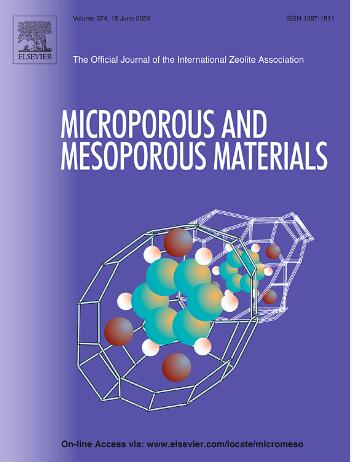Investigating the role of zeolite supports in Ni-based catalysts for CO2-methanation using in situ/operando XAS–GC-MS
IF 4.8
3区 材料科学
Q1 CHEMISTRY, APPLIED
引用次数: 0
Abstract
Nickel (Ni) is regarded as the most effective non-noble metal catalyst for CO2 methanation. Its performance is strongly influenced by support material and Ni reducibility. This study investigates the impact of zeolite types (ANA, LTA, and ZSM-5) on the reducibility and catalytic performance of 5 wt% Ni catalysts, compared with SiO2. Reducibility, measured via in situ X-ray absorption spectroscopy (XAS) from 100 to 450 °C, followed the order: 5Ni/ZSM-5 > 5Ni/ANA > 5Ni/LTA > 5Ni/SiO2. Catalytic testing in a fixed-bed flow reactor revealed the highest CO2 conversion at 400 °C, following the order: 5Ni/LTA > 5Ni/ZSM-5 > 5Ni/ANA > 5Ni/SiO2. Zeolite-supported catalysts achieved significantly higher CH4 selectivity compared to 5Ni/SiO2, with the trend: 5Ni/LTA > 5Ni/ZSM-5 > 5Ni/ANA ≫ 5Ni/SiO2. Comprehensive characterization using X-ray diffraction, N2 adsorption-desorption, and X-ray photoelectron spectroscopy was conducted to analyze catalyst properties. The CO2 methanation mechanism was deduced using data from in situ XAS-MS. These findings demonstrate that zeolite-supported Ni catalysts, particularly 5Ni/LTA, exhibit superior reducibility and catalytic performance, advancing the development of efficient materials for CO2 conversion.

求助全文
约1分钟内获得全文
求助全文
来源期刊

Microporous and Mesoporous Materials
化学-材料科学:综合
CiteScore
10.70
自引率
5.80%
发文量
649
审稿时长
26 days
期刊介绍:
Microporous and Mesoporous Materials covers novel and significant aspects of porous solids classified as either microporous (pore size up to 2 nm) or mesoporous (pore size 2 to 50 nm). The porosity should have a specific impact on the material properties or application. Typical examples are zeolites and zeolite-like materials, pillared materials, clathrasils and clathrates, carbon molecular sieves, ordered mesoporous materials, organic/inorganic porous hybrid materials, or porous metal oxides. Both natural and synthetic porous materials are within the scope of the journal.
Topics which are particularly of interest include:
All aspects of natural microporous and mesoporous solids
The synthesis of crystalline or amorphous porous materials
The physico-chemical characterization of microporous and mesoporous solids, especially spectroscopic and microscopic
The modification of microporous and mesoporous solids, for example by ion exchange or solid-state reactions
All topics related to diffusion of mobile species in the pores of microporous and mesoporous materials
Adsorption (and other separation techniques) using microporous or mesoporous adsorbents
Catalysis by microporous and mesoporous materials
Host/guest interactions
Theoretical chemistry and modelling of host/guest interactions
All topics related to the application of microporous and mesoporous materials in industrial catalysis, separation technology, environmental protection, electrochemistry, membranes, sensors, optical devices, etc.
 求助内容:
求助内容: 应助结果提醒方式:
应助结果提醒方式:


